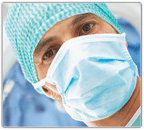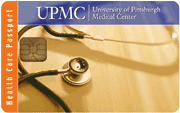European Hospital Implements RFID To Track, Trace and Improve Patient Health
30 May, 2006
category: Biometrics, Health, RFID
Jena University Hospital (in Jena, Germany) has high hopes on reducing medication errors (and improving patient care) with internationally based SAP AG’s NetWeaver software package – which it will implement ASAP, says a news release.
By applying RFID hardware infrastructure provided by Intel® Solution Services — including port scanners, communication and radio devices and RFID tags — the hospital will extend its deployment of SAP NetWeaver, using the platform’s auto-ID infrastructure to identify, track and match medication accurately and in real-time from the hospital’s pharmacy until they are administered to patients, according to a news release.
- This means several things, including:
- more cost-effective treatment;
- higher quality medical care; and
- improved patient safety (as a result of reducing undesired medication effects).
Jena University Hospital Leads Healthcare Innovation with RFID Solution from SAP
May 30, 2006
RFID Tracking of Medication and Medical Assets to Optimize Patient Care at Major German Medical Institute
FRANKFURT, Germany and PARIS, France – Further demonstrating the added value and innovation of industry-specific applications on the SAP NetWeaver® platform, SAP AG (NYSE: SAP) today announced the implementation of a groundbreaking healthcare solution leveraging SAP® software and radio frequency identification (RFID) technology at the University Hospital of Jena, Germany. By applying RFID hardware infrastructure provided by Intel® Solution Services—including port scanners, communication and radio devices and RFID tags—the hospital will extend its deployment of SAP NetWeaver, using the platform’s auto-ID infrastructure to identify, track and match medication accurately and in real-time from the hospital’s pharmacy until they are administered to patients. In addition to operating more cost-effectively throughout the whole treatment process, Jena University Hospital aims to increase the service quality in medial care as well as the safety of patients by reducing undesired medication effects.
The announcement was made at the International Forum of Healthcare IT (ITeG), being held in Frankfurt, Germany, May 30–June 1, and at SAP’s international customer conference SAPPHIRE® ’06, being held in Paris, France, May 30 – June 1.
Together with SAP, Jena University Hospital performed a detailed analysis of the three core processes supporting patient medication in order to integrate them into a single RFID-based process. By using passive RFID tags, medication can be tracked in real-time from the hospital’s pharmacy to intensive care and individual patients. Medication will be matched digitally to the individual patient by checking the reference codes on an RFID bracelet worn by the patient. Using handheld scanners, the nursing staff can read these codes, link them to the patient data on file in the hospital’s IT system and gain instant access to detailed information on the patient, displayed on a screen. By gaining the ability to track and match medication throughout the organization in real-time, the hospital aims to reduce the risk of any dispensing errors.
In addition, the system is designed to record all medication in the patient’s file automatically, including details about type, quantity and time of medication. In order to ensure an end-to-end process from the pharmacy to the patient, all unit doses of patient medication, transport boxes of the pharmacy and steel containers of the automatic, internal transport system are to be equipped with RFID tags. The roll-out of the solution will initially encompass 24 beds in intensive care and as a next step be expanded to another 65 treatment units. Jointly implemented by SAP and Intel Solution Services, the RFID infrastructure project is expected to be completed by October 2006.
“International studies reveal that approximately every 20th patient suffers an adverse drug effect, and about 55 percent of these cases could be avoided,” said Dr. Michael Hartmann, director of the pharmacy at Jena University Hospital and member of the Council of Europe Committee of Experts on pharmaceutical issues. “We have selected SAP technology to expand our existing SAP NetWeaver environment and to enable the innovative use of RFID. This technology will enhance the security of our drug supply chain and reduce potential adverse drug effects.”
In addition to an improved quality of treatment, the RFID infrastructure will help optimize logistics processes and enable demand-driven supply management, thus reducing the amount of capital locked up in the university pharmacy’s inventory. The new infrastructure will enable digital identification and immediate tracing of drugs down to the level of individual unit doses and also alert pharmacy staff as to the expiration dates of medication.
Jena University Hospital also plans to use the new solution to expand its medical expertise. Based on an anonymous documentation of drugs administered to patients, the hospital hopes to discover correlations between disease patterns and potential drug incompatibilities, enabling medical staff to better determine alternative treatments.
“The RFID project at Jena University Hospital is a perfect example of a growing number of innovative applications of RFID that go beyond the retailer and government mandates to drive real business value,” said Dr. Krish Mantripragada, global RFID program director, SAP. “The resulting solution is unique in the market and further validates SAP’s vision of real-world awareness.”
About University Hospital of Jena
The University Hospital of Jena (UHJ) is the only university clinic in the German state of Thuringia with more than 200 years of history. It is the largest employer in the region, with a staff of more than 4,000. Each year, 250,000 patients are treated in stationary and ambulatory care at UHJ’s 26 clinical facilities, comprising an overall capacity of 1,375 beds. Around 1,900 students of medical science and dentistry are in practical medical training at UHJ. Scientists from more than 25 nations lead the research and development efforts of the hospital’s 25 institutes. The UHJ emergency team was called approximately 4,100 times in the year 2005; the rescue helicopter was deployed more than 1,000 times. The main focuses of ambulatory operations at UHJ are ophthalmology, gynecology, obstetrics, ENT medicine and urology as well as oral, jaw and facial surgery. Further information is available at http://www.uniklinikum-jena.de/
About SAP
SAP is the world’s leading provider of business software*. Today, more than 33,200 customers in more than 120 countries run SAP® applications—from distinct solutions addressing the needs of small and midsize enterprises to suite offerings for global organizations. Powered by the SAP NetWeaver® platform to drive innovation and enable business change, SAP software helps enterprises of all sizes around the world improve customer relationships, enhance partner collaboration and create efficiencies across their supply chains and business operations. SAP solution portfolios support the unique business processes of more than 25 industries, including high tech, retail, financial services, healthcare and the public sector. With subsidiaries in more than 50 countries, the company is listed on several exchanges, including the Frankfurt stock exchange and NYSE under the symbol “SAP.” (Additional information at http://www.sap.com/)
(*) SAP defines business software as comprising enterprise resource planning and related applications such as supply chain management, customer relationship management, product life-cycle management and supplier relationship management.
Any statements contained in this document that are not historical facts are forward-looking statements as defined in the U.S. Private Securities Litigation Reform Act of 1995. Words such as “anticipate,” “believe,” “estimate,” “expect,” “forecast,” “intend,” “may,” “plan,” “project,” “predict,” “should” and “will” and similar expressions as they relate to SAP are intended to identify such forward-looking statements. SAP undertakes no obligation to publicly update or revise any forward-looking statements. All forward-looking statements are subject to various risks and uncertainties that could cause actual results to differ materially from expectations The factors that could affect SAP’s future financial results are discussed more fully in SAP’s filings with the U.S. Securities and Exchange Commission (“SEC”), including SAP’s most recent Annual Report on Form 20-F filed with the SEC. Readers are cautioned not to place undue reliance on these forward-looking statements, which speak only as of their dates.
Copyright © 2006 SAP AG. All rights reserved.
SAP, R/3, mySAP, mySAP.com, xApps, xApp, SAP NetWeaver and other SAP products and services mentioned herein as well as their respective logos are trademarks or registered trademarks of SAP AG in Germany and in several other countries all over the world. All other product and service names mentioned are the trademarks of their respective companies. Data contained in this document serve informational purposes only. National product specifications may vary.
For customers interested in learning more about SAP products:
Global Customer Center: +49 180 534-34-24
United States Only: 1 (800) 872-1SAP (1-800-872-1727)



